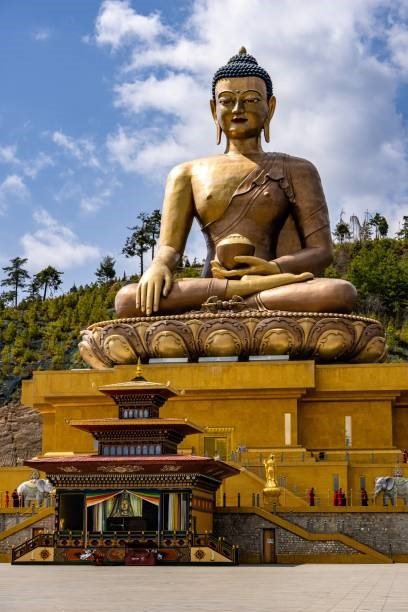Bhutan, the Land of the Thunder Dragon, is a kingdom nestled high in the Eastern Himalayas, renowned for its breathtaking landscapes, pristine environment, and unique cultural heritage deeply rooted in Buddhism. Its commitment to Gross National Happiness (GNH) prioritizes sustainable development, cultural preservation, environmental conservation, and good governance, resulting in a country where natural beauty thrives. Exploring Bhutan’s stunning natural wonders is an immersive experience, offering everything from snow-capped peaks to subtropical forests. Here are some of the must-see natural attractions:
1. The Majestic Himalayas:
Bhutan’s northern border is dominated by the towering peaks of the Eastern Himalayas, a dramatic and awe-inspiring spectacle.
- Jomolhari (7,326 m / 24,035 ft): This iconic snow-capped peak is considered sacred and is a prominent feature in Bhutanese folklore. The Jomolhari Trek is one of the most popular and challenging treks in Bhutan, offering stunning views of the mountain, alpine meadows, and glacial valleys.
- Gangkhar Puensum (7,570 m / 24,836 ft): Believed to be the highest unclimbed mountain in the world, Gangkhar Puensum holds a mystical aura. While climbing is prohibited out of respect for local beliefs, its majestic presence dominates the landscape in northern Bhutan.
- Other Notable Peaks: Numerous other impressive peaks, such as Jichu Drake, Masanggang, and Tserim Kang, contribute to Bhutan’s dramatic skyline and offer challenging trekking opportunities.
2. Phobjikha Valley: A Glacial Gem and Black-Necked Crane Habitat:
This U-shaped glacial valley is a broad and picturesque landscape, particularly famous as the wintering ground for the endangered black-necked cranes.
- Black-Necked Cranes: Witnessing these elegant birds arrive in late autumn and depart in early spring is a truly special experience. The Royal Society for Protection of Nature (RSPN) visitor center provides information and viewing opportunities.
- Gentle Hiking Trails: The valley offers numerous easy to moderate hiking trails through its open meadows, alongside meandering rivers, and past traditional villages. The Gangtey Nature Trail is a popular choice.
- Gangtey Monastery: Perched on a ridge overlooking the valley, this important monastery offers stunning panoramic views of the Phobjikha Valley.
3. Jigme Dorji National Park: A Biodiversity Hotspot:
Bhutan’s largest national park, spanning diverse altitudinal zones from subtropical forests to alpine meadows and glaciers, is a haven for biodiversity.
- Diverse Flora and Fauna: The park is home to numerous endangered species, including the snow leopard, takin (Bhutan’s national animal), red panda, Himalayan black bear, and various species of birds, including the black-necked crane.
- Trekking Routes: Several challenging trekking routes traverse the park, offering incredible opportunities to experience Bhutan’s pristine wilderness. The Snowman Trek, one of the world’s most challenging treks, passes through this park.
- Glacial Lakes and Rivers: The park encompasses numerous glacial lakes and the headwaters of several major rivers, contributing to Bhutan’s vital water resources.
4. Bumdeling Wildlife Sanctuary: Eastern Bhutan’s Natural Treasure:
Located in northeastern Bhutan, this sanctuary protects a diverse range of habitats, from broadleaf forests to alpine meadows.
- Endangered Species: The sanctuary is home to the white-bellied heron (one of the world’s rarest birds), snow leopard, red panda, and numerous other unique species.
- Cultural Significance: The region also has significant cultural importance with several sacred sites and traditional communities.
- Remote and Pristine: Its remoteness contributes to its pristine environment and offers a chance to experience a less-visited part of Bhutan.
5. Dochula Pass: Panoramic Himalayan Views:
This mountain pass, situated on the road between Thimphu and Punakha, offers breathtaking panoramic views of the snow-capped Himalayan peaks on a clear day.
- 108 Chortens (Stupas): The pass is adorned with 108 chortens known as the “Druk Wangyal Chortens,” built to honor Bhutanese soldiers and promote peace and harmony.
- Royal Botanical Park: Nearby, the Royal Botanical Park, Lamperi, showcases Bhutan’s rich floral biodiversity, including numerous rhododendron species.
- Scenic Stopover: Dochula Pass is a popular stop for travelers to admire the scenery and soak in the serene atmosphere.
6. Hot Springs (Tshachus): Natural Healing:
Bhutan is blessed with numerous natural hot springs, known as “tshachus,” believed to have medicinal properties.
- Gasa Tshachu: One of the most popular and well-developed hot springs, located in northern Bhutan.
- Duer Hot Springs: Located in the remote Bumthang region, these hot springs require a trek to reach and offer a more rustic experience.
- Relaxation and Rejuvenation: Soaking in the mineral-rich waters of these hot springs is a traditional Bhutanese practice for relaxation and healing.
7. Subtropical Forests and Waterfalls:
Southern Bhutan experiences a warmer, subtropical climate, supporting lush forests and cascading waterfalls.
- Chukha and Sarpang Regions: These regions are characterized by their dense forests, diverse plant life, and warmer temperatures.
- Waterfalls: While not as widely known as other attractions, numerous waterfalls can be found in these regions, often requiring short hikes to reach. They offer refreshing beauty and a glimpse into the lower altitude ecosystems.
Experiencing Bhutan’s Natural Wonders Responsibly:
Bhutan’s commitment to GNH emphasizes environmental conservation. When exploring its natural wonders, it’s crucial to:
- Respect the Environment: Avoid littering, stay on marked trails, and minimize your impact on the delicate ecosystems.
- Support Sustainable Tourism: Choose eco-friendly accommodations and tour operators who prioritize conservation.
- Respect Local Customs and Beliefs: Many natural sites are considered sacred. Dress modestly and be mindful of local traditions.
- Obtain Necessary Permits: Certain areas, especially national parks and trekking routes, require permits. Your tour operator will typically arrange these.
Conclusion:
Bhutan’s stunning natural wonders are an integral part of its charm and a testament to its commitment to environmental preservation. From the towering Himalayas and glacial valleys to the unique biodiversity of its national parks and the therapeutic hot springs, exploring Bhutan’s natural beauty is an enriching and unforgettable experience. It’s a journey that not only captivates the senses but also offers a profound appreciation for the harmonious coexistence of nature and culture in this remarkable Himalayan kingdom.


0 Comment